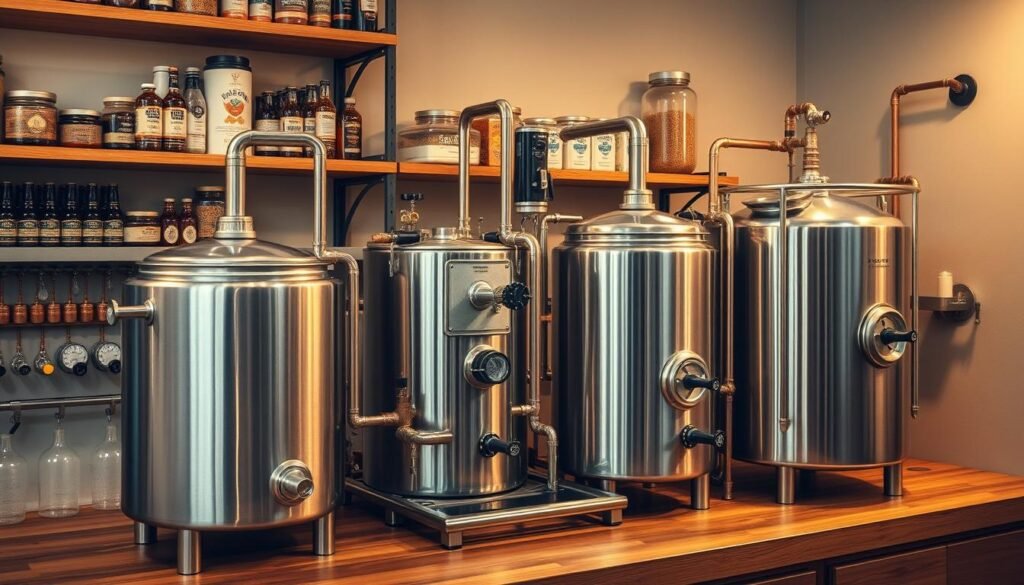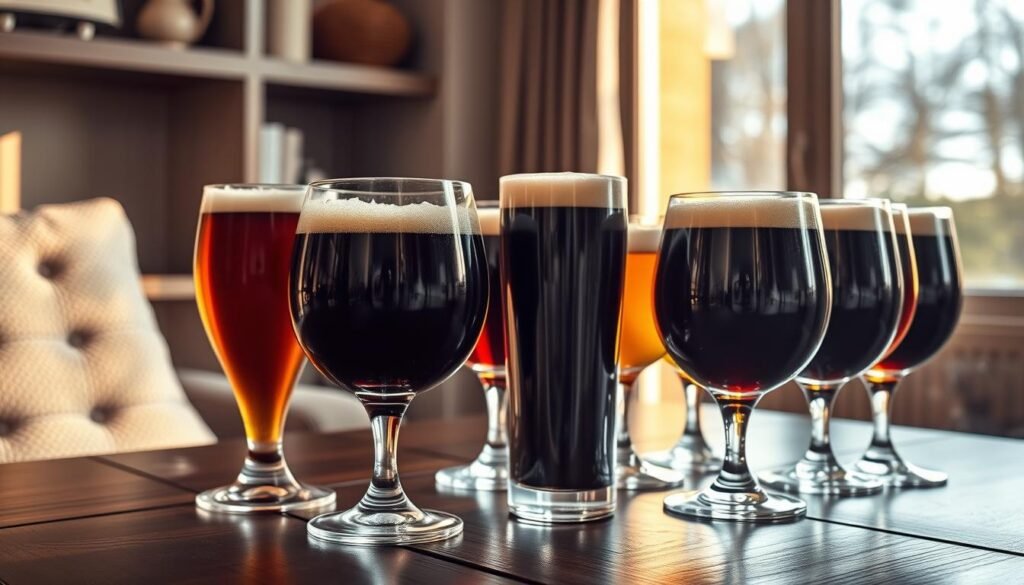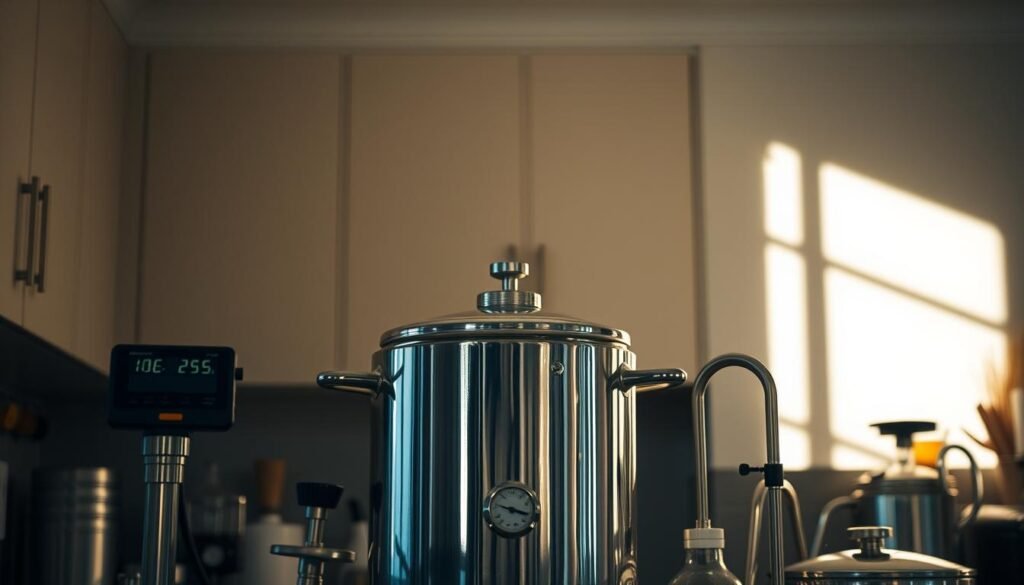As I explore brewing, I’ve found that stronger beers are forgiving for beginners. Their bold flavors and high alcohol content hide small mistakes. This lets new brewers try and improve their skills without worry.
Stronger beers are perfect for beginners. They offer a chance to learn and make great beer. By understanding brewing mistakes and how stronger beers cover them up, beginners can start their brewing journey with confidence.
Stronger beers have complex flavors that can hide small brewing errors. This makes them great for beginners. They can focus on improving without being held back by small mistakes.
Exploring stronger beers helps brewers learn the brewing process. They can develop skills to make amazing beers that impress everyone.
Introduction to Stronger Beers
To brew stronger beers, you need to know the brewing basics. This includes controlling temperature, choosing the right yeast, and how to ferment. Mastering these skills lets brewers make complex, full-bodied beers that show off their talent.
Whether you’re new or experienced, stronger beers open up a world of possibilities. They let brewers experiment and be creative, pushing the limits of flavor and taste.
Key Takeaways
- Stronger beers can mask minor flaws, making them ideal for beginner brewers
- Beginner-friendly beer styles, such as stronger beers, offer a unique opportunity for brewers to hone their skills
- Understanding the science behind brewing mistakes is crucial for creating exceptional stronger beers
- Temperature control, yeast selection, and fermentation techniques are essential for brewing stronger beers
- Stronger beers offer a world of possibilities for experimentation and innovation
- Brewing stronger beers requires a solid understanding of the brewing process
- Stronger beers can conceal minor errors in the brewing process, making them a great choice for new brewers
Understanding Why Stronger Beers Are Forgiving for Beginners
Starting with stronger beers can be a good choice for beginners. These beers have more alcohol, which can hide small mistakes. This is key for those new to brewing mistakes, as it can be upsetting.
The science behind this is interesting. Alcohol content makes the beer’s flavors and smells stronger. This means small errors are less noticeable. Stronger beers also have complex tastes, making it easier to cover up small mistakes. Many experts suggest starting with styles like Belgian Tripels or Russian Imperial Stouts for beginners.
Starting with stronger beers has many benefits:
- More forgiving flavor profile
- Opportunity to experiment with different beer brewing techniques
- Development of skills and confidence in brewing
Understanding alcohol content in beer brewing helps beginners. They can use stronger beers to learn and improve. With time and effort, anyone can become skilled at brewing and make tasty, complex beers.
Essential Equipment for Brewing Higher ABV Beers
Exploring the world of brewing higher ABV beers shows how crucial the right brewing equipment is. It’s not just about having fancy gear. It’s about controlling every step, from fermentation to bottling. For example, fermentation temperature control is key. It lets brewers adjust the temperature for the best yeast performance.
For brewing stronger beers, a top-notch brewing vessel is essential. It must handle the extra pressure and temperature changes. Also, a good fermentation temperature control system is vital. It keeps the fermentation temperature just right, depending on the yeast and beer style.

- High-quality brewing vessels
- Fermentation temperature control systems
- Accurate thermometers and hydrometers
- Sanitization and cleaning equipment
Investing in the right brewing equipment and knowing the value of fermentation temperature control helps brewers make top-notch, higher ABV beers. These beers are full of flavor and character.
Beginner-Friendly Beer Styles: Stronger Beers that Can Mask Minor Flaws
As a brewer, I’ve learned that stronger beers can hide minor flaws. Styles like Belgian Tripels, Russian Imperial Stouts, and Barleywines are great for beginners. They’re easy to brew and help build confidence.
Understanding each style is key when brewing stronger beers. Belgian Tripels have golden colors and fruity, spicy tastes. Russian Imperial Stouts are dark with rich, roasted flavors. Barleywines offer complex tastes, from sweet to hoppy.
Some key features of these beginner-friendly beer styles include:
- Belgian Tripels: fruity and spicy flavors, golden color, and a moderate to high ABV
- Russian Imperial Stouts: dark color, rich and roasted flavors, and a high ABV
- Barleywines: complex and nuanced flavors, ranging from sweet and malty to hoppy and bitter, and a high ABV

By understanding these styles, new brewers can make amazing beers. Whether it’s a Belgian Tripel, Russian Imperial Stout, or Barleywine, success comes from detail and a love for learning.
Temperature Control Techniques for Strong Beer Success
Exploring the world of brewing stronger beers, I’ve learned how vital temperature control is. It’s key for managing fermentation temperature, which impacts the beer’s taste and character. With the right methods, brewers can craft beers that are rich, complex, and full of depth.
Managing fermentation temperature depends on the yeast type and the flavor desired. Proper temperature control prevents off-flavors and smooths the fermentation. Storage and aging also shape the beer’s character. Controlling temperature during these stages can refine the flavor.
Important temperature control points include:
- Investing in a temperature control system for consistent fermentation temperatures
- Using insulation to manage temperature changes during storage and aging
- Monitoring temperature to avoid spoilage or off-flavors
Mastering temperature control unlocks the full potential of stronger beers. It leads to a more complex and refined flavor. With the right temperature control, fermentation management, and aging, brewers can create exceptional beers. These showcase their skills and craftsmanship.

Key Ingredients for Brewing Stronger Beers
When brewing stronger beers, the quality of brewing ingredients is key. As a brewer, I know the right mix of ingredients is crucial. Yeast selection is especially important for flavor and aroma.
Choosing the right yeast can highlight the best in hops and grains. For instance, some yeast strains are perfect for stronger beers like Belgian Tripels or Russian Imperial Stouts. This choice helps create a beer that’s strong, complex, and full of flavor.
Some essential brewing ingredients for stronger beers include:
- High-quality grains, such as specialty malts
- Aromatic hops, such as Saaz or Hallertau
- Yeast strains, such as Trappist or English ale yeast
By picking the right brewing ingredients and focusing on yeast selection, brewers can craft stronger beers that are tasty and unique. Whether you’re experienced or new, the right ingredients are vital for a great beer.
Common Brewing Mistakes and How Strong Beers Hide Them
As a brewer, I’ve found that even with top-notch gear and ingredients, mistakes can happen. Stronger beers can cover up small errors, but knowing common mistakes is key. Issues like temperature changes and managing yeast stress can really mess up our beer’s taste and character.
Temperature fluctuations during fermentation are a big problem. If the temperature isn’t steady, it can cause bad flavors and lower the beer’s quality. Managing yeast stress is also vital, as stressed yeast can create unwanted compounds that ruin the beer’s taste and smell.
To steer clear of these errors, keeping an eye on temperature changes and managing yeast stress is crucial. This way, we can brew amazing stronger beers that show off our skills. Here are some tips to avoid common mistakes:
- Watch the fermentation temperature closely
- Choose high-quality yeast and use good yeast stress management
- Keep fermentation conditions in check to avoid bad flavors
By following these tips and knowing about common mistakes, we can make tasty and complex stronger beers. These will surely impress even the pickiest drinkers.
Mastering the Mash for Higher Gravity Brews
As I explore brewing, I’ve learned that mashing is key for making stronger beers. Mashing turns grain starches into sugars that yeast can eat. This is vital for brewing beers with more kick.
Controlling temperature, water quality, and grain choice are crucial during mashing. This ensures the best results for your brew.
Enzymes play a big role in mashing. They break down starches into sugars that yeast can turn into alcohol. Knowing how enzymes work helps brewers make stronger beers. These beers can hide small mistakes, making them great for beginners.
Here are some tips for mastering the mash:
* Choose high-quality grains for more sugars
* Keep the temperature right for enzyme activity
* Make sure your water is good for brewing
By following these tips, brewers can make beers with lots of flavor. Whether you’re new or experienced, getting the mash right is key to making great beer.
Fermentation Strategies for Strong Beer Styles
Exploring brewing stronger beers, I’ve learned how crucial fermentation strategies are. This process turns simple ingredients into complex, full-bodied beers. It’s key to grasp the importance of yeast selection and nutrient needs in this journey.
Yeast Selection and Pitching Rates
Choosing the right yeast is vital in fermentation strategies. Different yeast strains can create unique flavors and characteristics. For stronger beers, yeast selection is key to the beer’s taste and aroma.
Nutrient Requirements for High ABV Brewing
Nutrients are essential for fermentation, especially in high ABV beers. The right nutrients help yeast grow and ferment, enhancing the beer’s flavor and quality. By knowing the nutrient requirements
Mastering fermentation strategies, like yeast selection and nutrient needs, unlocks a beer’s full potential. Whether you’re experienced or new, understanding fermentation can lead to creating outstanding beers. These showcase your skills and craftsmanship.
Aging and Conditioning Requirements
Proper aging and conditioning are key for making top-notch stronger beers. As these brews age, their flavors and aromas grow, making for a special drinking experience. Bottle conditioning requires patience, as it naturally carbonates the beer over time. This creates a smooth, well-blended carbonation that matches the beer’s strong character.
Bottle Conditioning Tips
To get the best bottle-conditioned strong beer, watch the temperature and timing closely. Keep the temperature steady, around 68-72°F, to help the yeast carbonate the beer well. Also, give it enough time, usually 4-6 weeks or more, for the carbonation to mix well with the brew.
Proper Storage Methods
Storing stronger beers needs careful attention. Don’t let direct light hit the bottles, as it can harm the flavor and aroma. Store them in a cool, dark spot, like a cellar or a beer fridge. Keeping the temperature between 55-65°F is important to keep the beer’s complex traits during aging.
By sticking to these aging and conditioning tips, you can bring out the best in your stronger beer creations. This will give you a truly amazing drinking experience that shows off the skill of brewing.


